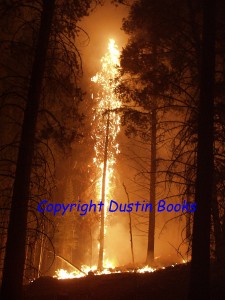My home is in the Rocky Mountains. The adjacent photograph of a burning tree is one I took in the summer of 2002 when the inevitable forest fires followed the mountain pine beetle epidemic that killed 90 percent of the ponderosa pines in this region. So a tree like this one was left standing in the woods with dry pine needles and dead branches. We called them “red tops,” kind of like a match. When fire moving along the ground reached this tree, it exploded into flame.It shouldn’t have happened. The pine beetles, which have always been present in the woods, don’t attack young trees. But because of constant objections, appeals and legal actions from environmental groups like the Sierra Club, logging has been curtailed in the national forests for decades. In the 1980s and 90s, you would be hard put to find a logging proposal from the U.S. Forest Service that was not opposed by these groups. They managed to delay one logging project in southern Wyoming for 13 years.
The result of this was the trees under the management and jurisdiction of Uncle Sam were all the same age – old. So when drought weakened the trees’ defenses, the pine beetle came along and decimated the forests. The irony is that if you come out here now, you’ll see millions of acres of dead trees, and isolated tracts of green trees. Those trees survived because they were young, and for the most part grew up on lands that were clearcut years and years ago. To my knowledge, there was not a single proposal for a clearcut in the 80s and 90s that was not opposed by environmental groups, so the irony is that the tracts of green trees in this region survived despite the efforts of the extreme environmental lobby.
This is not a logical conclusion resulting from hindsight. Professional forest managers were telling the U.S. Forest Service and the rest of the world that a policy of putting out forest fires and not logging was creating an unnatural situation – that of all the trees being the same age. Mom Nature never intended that. But you couldn’t explain that to the environmental groups that were not only curtailing logging, but also collecting taxpayers’ money in judgment awards resulting from their lawsuits. Do you donate to these groups? You don’t need to. They are doing estremely well financially.
And here’s another irony. When the Forest Service approved logging projects back in the day, the loggers paid the Forest Service for the trees. Now the Forest Service is having to pay loggers to remove dead trees that threaten power lines, roads, campgrounds, watersheds, trails and the like. And when the forest burns, it puts literally tons of pollutants into the sky and into our streams.
And the government has done other idiotic things in the management of the forests. It’s federal law that the forests are to be managed for multiple uses, including logging to help provide the nation with lumber. But often it has become cheaper to buy a two-by-four that was cut in Russia, planed in Poland and shipped to the U.S. than from a regular old American tree. During one decade, the U.S. government was charging loggers 100 times the charge for a similar tree cut in Canada. So, one half of all the sawmills in the West went out of business between 1980 and 2000.
I’m telling this story for three reasons. One is this is the type of commentary you are going to find on this website. I’ve been a journalist for 40 years. It’s what my college degree was in, and it’s been my only career. I retired in 2013, but I can’t help myself from pointing out the obvious. Hence, this website. Second, the photos you see on these pages are available for sale. I will be selling limited editions of each one. And finally, I am a writer, so I wrote some books. They also are available for sale through this website, if you’re interested.
Thanks for visiting.

